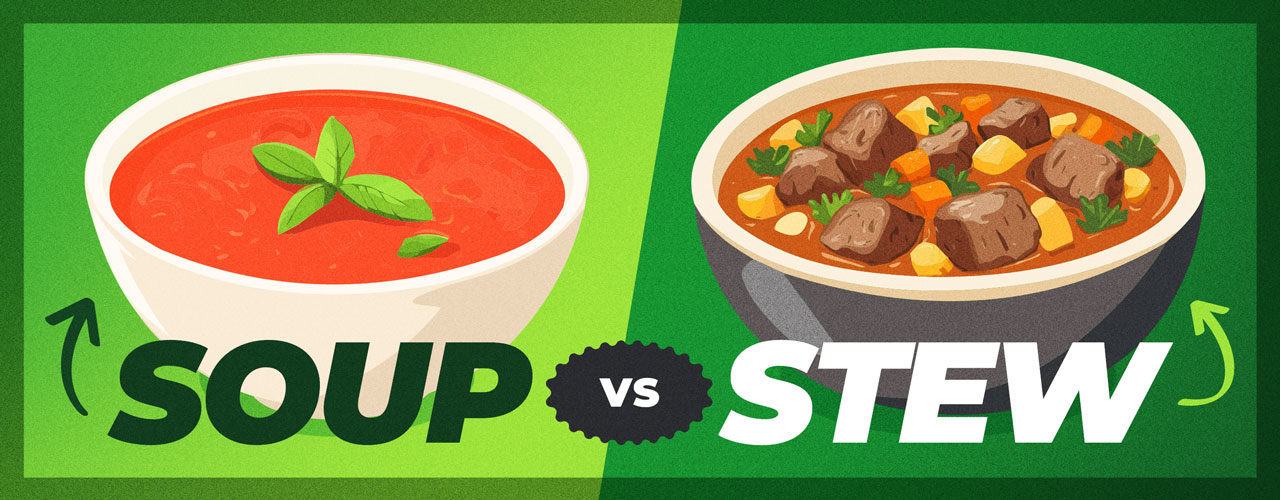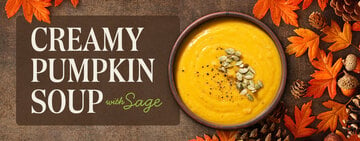Soup vs. Stew
Last updated on Sep 17, 2025Jason KurtzWhen it comes to building out your menu, especially during the fall and winter months, incorporating soups and stews are a fantastic opportunity for seasonal flavors with cost-saving potential. Though the terms are used interchangeably, these dishes are distinct in their own right. Both are staples in households and on menus across the globe, offering warmth in every spoonful. While both soup and stew might feature the same ingredients, they differ significantly in texture and consistency. Knowing the distinctions between these beloved dishes will help you curate a menu that meets the diverse tastes and preferences of your customers.
What Is Soup?

Soup is a liquid-based dish that many consider a comfort food. It typically features a combination of vegetables, meat, seafood, noodles, or legumes simmered in a flavorful stock or broth. Soup is often prepared in a large stockpot or steam kettle, allowing the flavors to meld as it simmers over low heat, ensuring that the ingredients release their full potential for a rich and satisfying dish. Additionally, the beauty of soup lies in its versatility and ease of preparation. Whether you're serving it as a side dish or as a hearty entree, it is a comforting addition to any menu.
Types of Soup
The easiest way to classify a soup is by its consistency, which impacts the overall dining experience as well as what to serve alongside the dish. Although there are other variations available, the three main types of soup include clear soup, thin soup, and thick soup.
- Clear soup: These soups feature minimal solid ingredients and a thin texture, often limited to herbs or spices, floating in a mixture of stock or broth. Common examples of thin soups include consomme and bouillon.
- Thin soup: Thin soups are still mostly broth-based, but with added ingredients like noodles, chunks of meat, and vegetables. Some of the most recognizable thin soups include chicken noodle soup and pho.
- Thick soup: This type of soup is often made using dairy products, such as milk, cream, or cheese, or select food thickening agents to achieve a rich, thick texture. Some of the most popular examples of thick soup include chowder, bisque, and French onion soup.
What Is Stew?

Stew is a hearty dish made from ingredients like meat, seafood, and vegetables. While it is still prepared in a liquid base, the liquid aspect is simmered until it makes up significantly less of the dish. This results in a thicker consistency and richer flavor profile. Typically, stew takes longer to cook than soup and is prepared in a dutch oven, crockpot, or tilt skillet, depending on the layout of your kitchen, creating tender meat and vegetables that are infused with the flavors of the cooking liquid.
Types of Stew
Unlike soup, there are fewer differences between the consistency and cooking methods of the different types of stews. The easiest way to classify stews is by their main ingredient, as this provides a distinguishing taste, color, and texture to each variation.
- Beef stew: Some of the best cuts of beef for beef stew include chuck, short rib, and oxtail. Common beef stew recipes include goulash or beef chili.
- Poultry stew: The most common types of poultry used for stew are chicken or turkey, with some of the best-known recipes including favorites like coq au vin and white chicken chili.
- Seafood stew: Seafood stews are a delightful choice for those who enjoy the flavors of the ocean. Commonly featuring shrimp and other seafood delicacies, it includes recipes like seafood gumbo and shrimp creole.
- Vegetable stew: Vegetable stews are a fantastic option for vegetarians and those looking for a lighter meal alternative. These stews often feature ingredients like carrots, onions, and potatoes, providing a harmonious blend of flavors and textures. Additionally, various types of legumes can be added to vegetable stews for added texture and a hearty flavor boost.
Soup and Stew FAQ

Though soup and stew are beloved and relatively easy to make, there are still plenty of questions about them. We'll answer some of the most common questions to help you curate the perfect menu.
When Is Soup Season?
Soup season typically refers to the fall and winter months. While there isn’t an exact start date or end date for soup season, it generally corresponds with the arrival of colder weather. As the temperatures drop, guests tend to crave heartier, warmer dishes and comforting foods.
How to Thicken Soup
When you're soup is too thin for your liking, it is still possible to thicken it up. Use these common kitchen ingredients to adjust the consistency of your soup to your preference on the fly.
- Starch: Create a starch slurry, using ingredients like cornstarch, to gradually blend into the soup. As the soup simmers, the starch will thicken the broth.
- Roux: To make a roux, mix equal parts of butter and flour in a saucepan over low heat until it forms a smooth paste. Once your roux is ready, gradually whisk it into your soup.
- Dairy products: If you prefer a creamy texture in your soup, add dairy products like milk or heavy cream to thicken it. Simply pour in the desired amount of milk or cream and continue to simmer or boil the soup until it reaches your desired thickness.
Understanding the differences between stew and soup is crucial for making informed decisions about what to include on your menu. Whether you're looking to offer a light and brothy soup for a quick lunch option or a hearty stew to warm up your patrons on a cold evening, there are many options for you to choose from and ways to prepare them. If you're looking to prepare soup in bulk, check out our commercial soup kettles and warmers.








